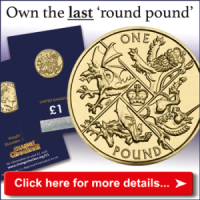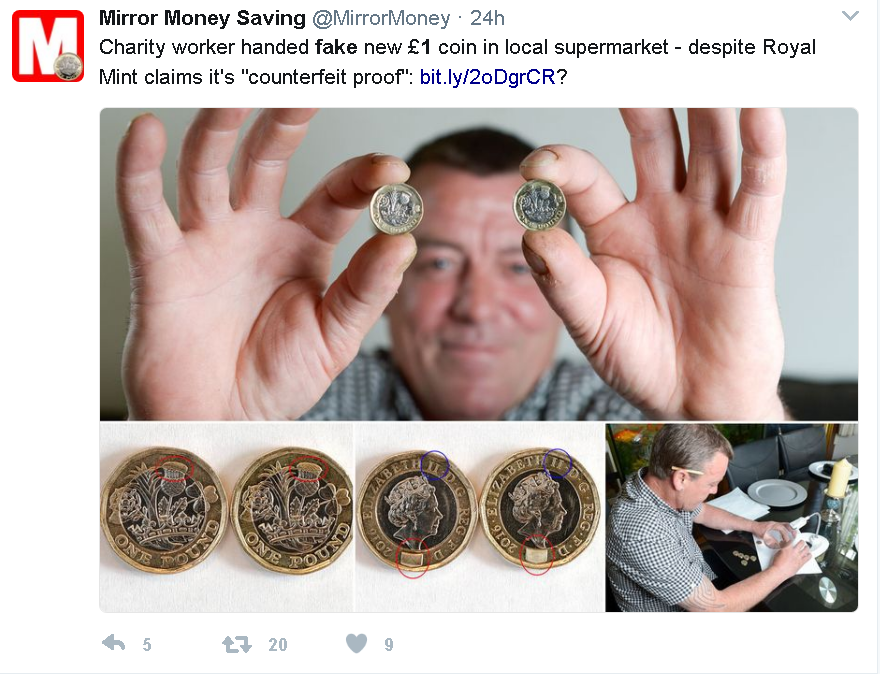Posts Tagged ‘One Pound’
Rumours of fake £1 coins denied by Royal Mint
The Royal Mint has denied claims that there are already counterfeit 12-Sided £1 coins in circulation after a charity worker pointed out discrepancies between two coins.
Roy Wright, a charity worker from Surrey, was shocked when he noticed a few subtle differences between the two £1 coins, leading him to believe he had found the ‘first fake £1 coin’.
Impossible to counterfeit
Despite the new £1 coins being designed to be ‘impossible to counterfeit’, Mr Wright suggested that coin he had was heavier, had no hologram and the Queen’s head was positioned more to the left. Not only that, the edges were more rounded and there was no detail on the head of the thistle.
A genuine coin with a production fault…
Whilst the story has caused some excitement in the press and The Royal Mint has not yet been able to examine the offending coin, they are confident it is not a fake, but instead a genuine coin with a production fault.
Despite tight quality controls being in place, The Royal Mint has said that variances are likely to occur during the striking process in a small numbers of coins. Whilst such mis-strikes are relatively unusual and can be numismatically interesting, they are not the same as genuine errors.
Rumours of a genuine error in circulation
Unconfirmed rumours have also been circulating about some new £1 coins featuring two dates. There are reports of some coins having 2016 on the obverse and 2017 engraved in the micro lettering of the reverse.
Although, we are yet to see an example, if this is true, it would have to be the result of mis-matched 2016 and 2017 dies being used during production – a genuine error or “mule”.
Of course, it was the use of an incorrect die that resulted in the most famous modern “error” – the “undated 20p coin“, now regarded by many as the Holy Grail of change collecting. You can read more about the story of the undated 20p here.
If you’ve #foundapound in your change, have you spotted anything strange about it?
These are the Top 10 tips to complete your £1 Coin Collection…
The Great One Pound Coin Race is well underway and lots of you have already managed to complete a full collection of £1 coins.
For those of you that haven’t don’t worry, there’s still time… but it is getting harder!
You’ve only got until 15 October to find all 24 circulating £1 coin designs so here are the Top 10 tips to complete your collection.
Since the release of the new 12-sided £1 coin last month, the new £1 has been turning up everywhere, and that means the round pounds will start to slowly disappear. That’s because the banks will stop issuing the round pounds and will start to take them out of circulation.
Lots of you have also come forward with your own tips and tricks for finding £1 coins…
How to enter the Great One Pound Coin Race
If you haven’t started your Great One Pound Coin Race yet, it’s not too late. Simply click here to enter today and you too could own a complete collection of £1 coins direct from your change before they’re gone for ever.
Poll: What is your favourite £1 Coin Design? – England
 As part of the Great One Pound Coin Race, we want to find out Britain’s ultimate favourite £1 coin.
As part of the Great One Pound Coin Race, we want to find out Britain’s ultimate favourite £1 coin.
Last week we asked you to vote for your favourite Welsh £1 coin design – it was very close but 35% of Change Checkers voted the 2013 Daffodil and Leek £1 as their favourite.
This week we want to know your favourite English £1 coin design.
Let us know by voting in our poll below:
More information about the English £1 coin designs
The first reverse design series of £1 coins took floral emblems as its theme to represent the United Kingdom and its four constituent countries. They were designed by Leslie Durbin – one of the most highly-regarded silversmiths of the 20th Century. The Oak Tree is used on this coin to represent England.
The second series of £1 coin designs used heraldic emblems to represent the United Kingdom and its four constituent countries. This coin features three lions to represent England. The three lions date back to Richard the Lionheart (1189-1199) who used three golden lions on a scarlet background as a powerful symbol of the English throne.
The third series of £1 coin designs depicts bridges from each of the four consituent countries in the United Kingdom. This coin features the Gateshead Millennium Bridge to represent England. The Gateshead Millennium Bridge is a tilt bridge which spans the River Tyne between Gateshead and Newcastle. It is the world’s first tilting bridge and has won a large number of awards for its design and lighting.
The fourth series of £1 coins used the capital cities of the four constituent countries as the basis of the reverse design. Designed by Stuart Devlin, Goldsmith and Jeweller to the Queen, this coin depicts the circular Coat of Arms of the City of London as the principal focus to represent England.
The fifth series of £1 coin designs uses pairs of floral emblems designed by Timoty Noad to represent the United Kingdom and its four constituent countries. This coin features an oak branch with an acorn alongside a stem with a tudor-inspired rose to represent England
Next week- Final: What’s your ultimate favourite £1 coin design?
 This could be your last chance to secure Britain’s last ’round pound’.
This could be your last chance to secure Britain’s last ’round pound’.
If you want to get your hands on the last ‘round pound’ they are available here protectively encapsulated and certified as superior Brilliant Uncirculated quality.








